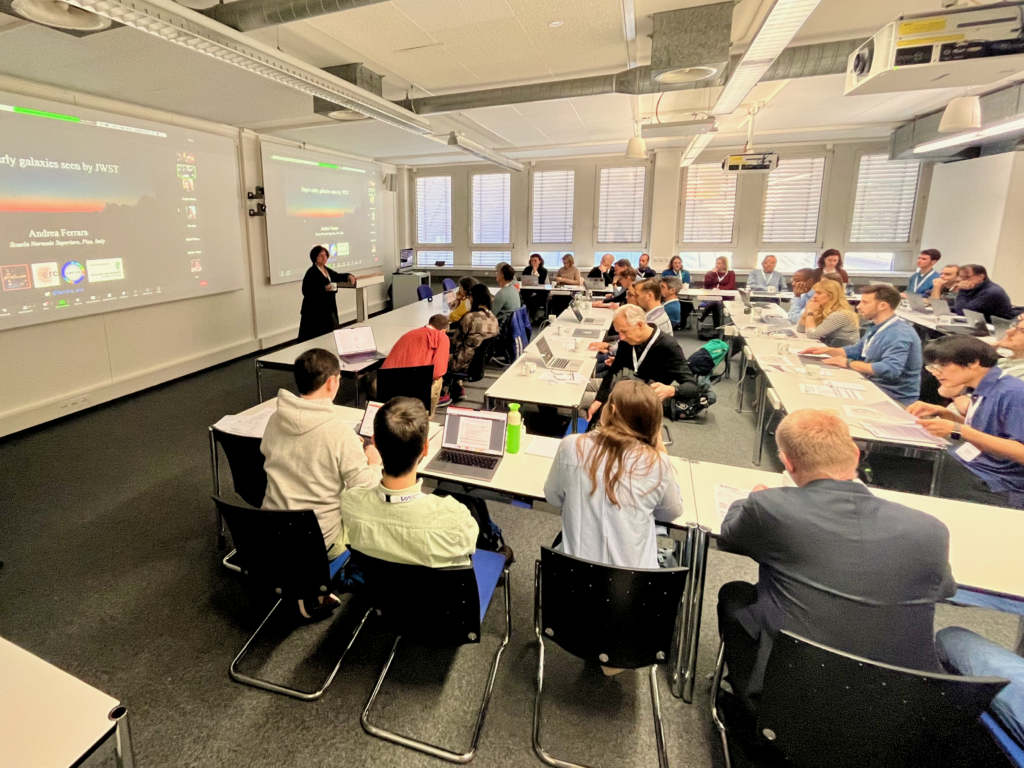
ISSI is currently witnessing a vibrant exchange of ideas as experts from across the globe are convening for the inaugural day of the “Chronology of the Very Early Universe According to JWST: The First Billion Years” workshop.
Together with Professor Christina Williams from the National Optical Infrared Astronomy Research Lab and Professor Kristen McQuinn from Rutgers, The State University of New Jersey, astrophysicist Professor Daniel Stark of the University of Arizona led the first discussions amongst the almost fifty experts probing the mysteries of the early universe, fuelled by the excitement surrounding new observations from the James Webb Space Telescope (JWST). Sitting in the comfortable couch in ISSI’s lunch room, Stark emphasises the importance of leveraging ISSI’s unique work environment to foster collaboration and bridge diverse perspectives.
Stark usually focusses on the first galaxies of the universe that were brought to light with the reionization after the early „dark ages“. Because the novel JWST observations produce a wealth of new insights on these topics too, new questions have arisen. Today, he therefore tried to shine light on those key aspects of the early universe for which the interdisciplinary participants can reach consensus in their understanding, and those for which they cannot.
While sharing experiences and pizza slices during lunch break, Dr. Susan Kassin of the Space Telescope Science Institute, along with Dr. Melanie Habouzit of the Max-Planck-Institute for Astronomy and Kirk Barrow of the University of Illinois Urbana-Champaign, point out the crucial interplay between modelling and observation in unraveling cosmic enigmas. To not inhibit out-of-the-box discoveries, Kassin reminds us that modelling should usually follow observations: „Making observations solely based on the current understanding inhibits unexpected insights“ and, as history tells us, this would slow down scientific advances immensely.
The three colleagues appreciate the welcoming environment here at ISSI and think that a workshop such as this one is key to bring the specialised knowledge and understanding on a more complete and broad level. This seems to be of particular importance, given the current inflow of new observations and understanding on the early universe. By meeting with other experts from different disciplines here at ISSI, they also think that this broader understanding will eventually trickle down to the entire community when the participants go home and disseminate their broader knowledge within their scientific circles.
Habouzit, Barrow, and Kassin think that the field moves in tune with the new (space science) instruments and their observations. Most JWST data becomes open-access quite quickly after it has been made, which opens the question whether research and researchers have become overly competitive and focus on quick academic success rather than elaborate, long-term research. While they agree that there is some unhealthy competition here and there, they also point out that thanks to the sheer amount of new and complex data distributed all over the sky, the collaborative rather than competitive approach is still possible and apparently more common.
One table further, postdoctoral scholars Dr. Seiji Fujimoto of the University of Texas at Austin and Dr. Rohan Naidu of the Massachusetts Institute of Technology are lauding ISSI’s inclusive atmosphere: „This workshop facilitates dialogue among researchers of varying experience levels.“ ALMA and Hubble used to provide them with sharp insights. Since recently, JWST observations are filling the plates of Naidu and Fujimoto. While Rohan stayed in the USA during his past career, Seiji has already worked in Japan, Europe, and now the USA. Well travelled or not, they agree that the ISSI setting allows them to learn from, and discuss with other international experts, also the ones that are more senior, in a unique way.
As discussions unfold, participants reflect on the transformative potential of collaborative research environments in shaping the future of astrophysics. Dr. Susan Kassin’s unconventional journey from aspiring artist to pioneering astrophysicist served as a testament to the power of curiosity and interdisciplinary exchange in driving scientific discovery.
With a commitment to nurturing a culture of collaboration and curiosity, the first ISSI Breakthrough Workshop promises to illuminate the cosmic dawn and inspire future generations of cosmic explorers.
Stay tuned for more insights and revelations from what feels like the forefront of astrophysical insights here at ISSI.
